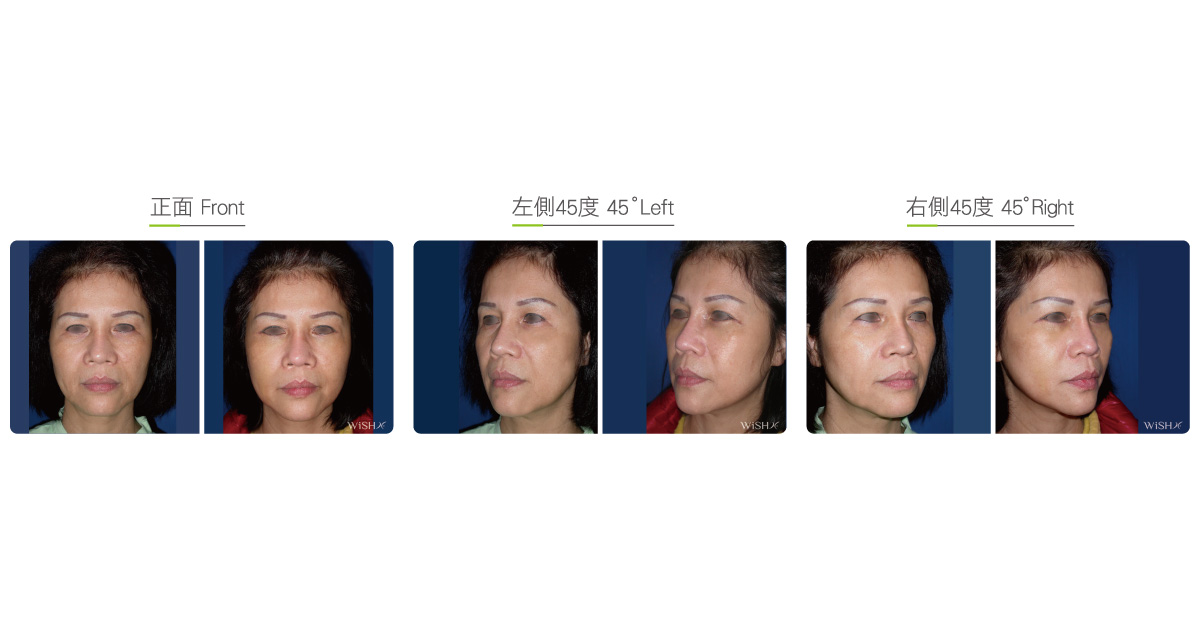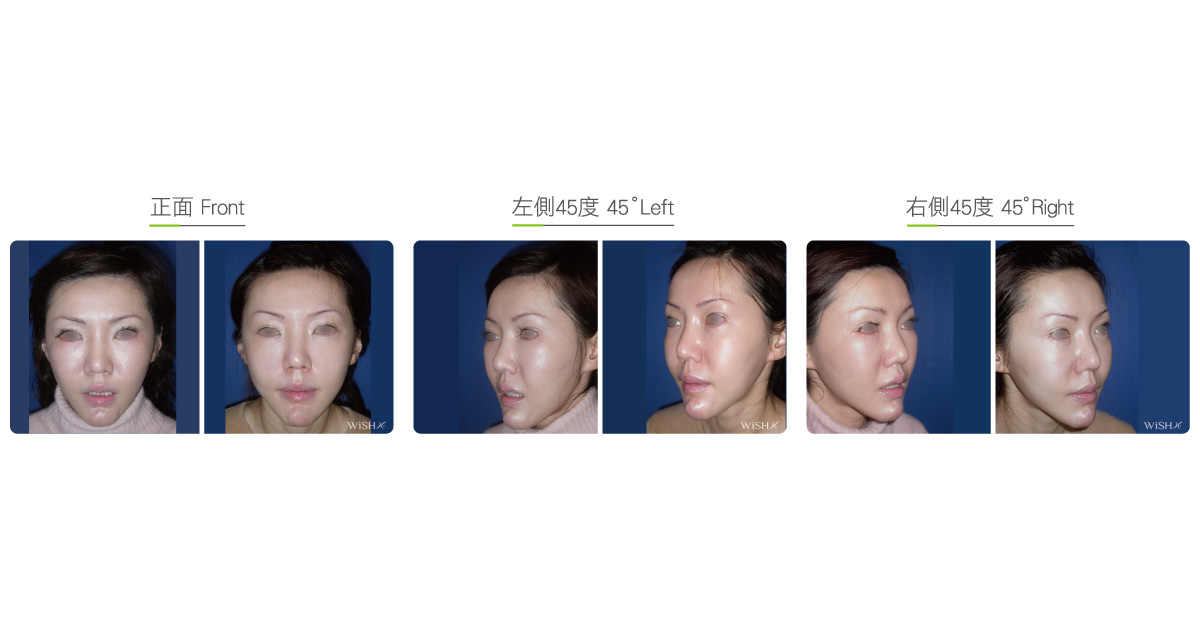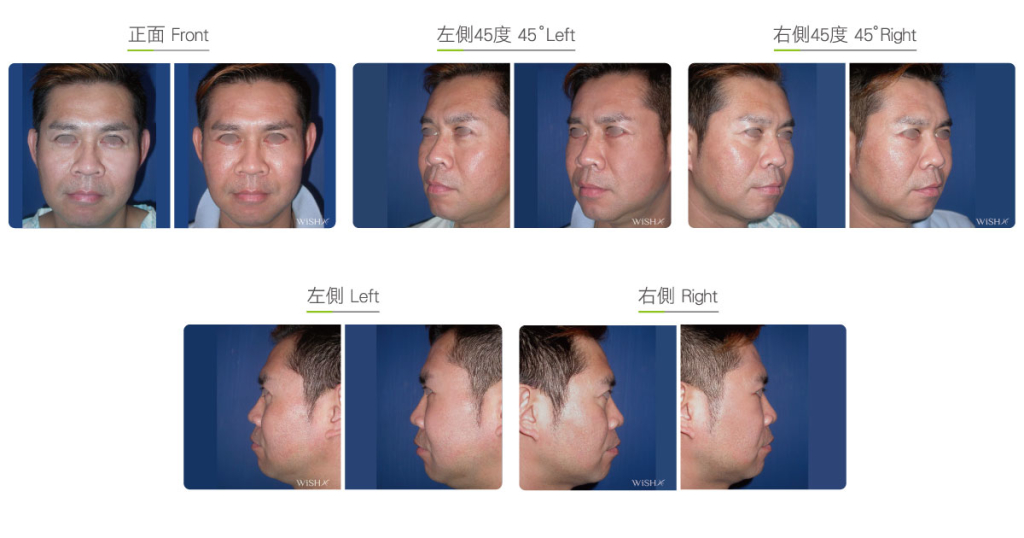Transciliary Midface Lift
Numerous patients with lower eyelid laxity or bulging have different degrees of midface sagging, typically characterized by hollow tear-through grooves that extend to the middle area of the cheek below the eye bag and result in a transverse furrow at the midface submalar triangle (commonly called “Indian’s wrinkles”) as well as deeper nasolabial folds. Such problems are mainly ascribed to early sagging and pulling of the cheek, which makes the original tear-through groove deeper and longer, and are different from the occurrence of an eye bag or tear-through groove caused by simple lower eyelid laxity. Therefore, both lower eyelid and midface sagging should be addressed so that the surgical effects are not compromised.
This surgery is conducted in a similar way to a lower blepharoplasty with eye bag removal. Dr. Chuang first makes an incision at the margin of the lower eyelid close to the eyelash line that ends at the eye tail (sub-ciliary incision), dissects the pouch skin, and removes excess fat via the incision before performing subperiosteal dissection at the cheekbone below the tear-through groove to above the nasolabial folds. This will release majority of the midface skin from bone. Then, Dr. Chuang will apply several lift threads or an Endotine midface implant under the skin to suspend the submalar triangle upward to the periosteum near the orbital bone where it is fixed. The level of fixation and number of sutures vary depending on the degree of skin laxity, and the surgical purpose is to re-elevate and restore the sagging or hollowing submalar triangle to its original position and effectively sculpt a 45° S-shaped curve. After the midface lift is done, pouch fat grafting to the tear-through groove may be conducted, and the loose lower eyelid skin is properly suspended and excised before wound closure.
Due to its proximity to the sagging skin and the execution of the deep periosteal dissection, this combined lower blepharoplasty and midface suspension surgery will closely adhere the skin and suture to the bones, which is therefore particularly effective to correct the tear-through groove and submalar triangle. It is appropriate for patients who want to improve eye bags and midface skin laxity at one time but are unwilling to accept endoscopic facelift.
Surgical conditions
Duration
- Type of anesthesia: IV sedation + local anesthesia
- Type of incision: At the eyelash line of the lower eyelid
- Recovery: 7–10 days
- Removal of sutures: 7–10 days
General instructions
No food and water on the day of surgery
- Rubbing or pressing the incisions on the forehead and scalp should be avoided for 1 month postoperatively.
- Hair dying or perming should be avoided for 2 months postoperatively to prevent unwanted irritation or allergy.
- Very good scalp care should be maintained for 3 months postoperatively to prevent hair loss.
Ideal candidates
- Individuals with a loose lower eyelid combined with midface skin sagging or obvious nasolabial folds.
- Individuals with eye bag bulging and lower eyelid laxity, which cause a deep tear-through groove.
- Individuals with severe eye bag bulging complicated with a deep tear-through groove and submalar triangle hollowing (Indian’s wrinkles).
- Individuals with a congenital hollow midface and loss of the submalar triangle.
- Individuals suffering from ectropion due to prior lower blepharoplasty requiring a second correction.
Potential complications
- Eyelid scar
- Ectropion
- Temporary cheek numbness
- Change of eye shape and size
Surgical advantages
-
Resolves eye bags and midface sagging at one time, eliminating the need for a separate midface lift.
-
No risk of nerve or blood vessel injury; highly safe.
-
Stable and long-lasting improvement of the tear-through groove.
-
Direct suspension and fixation of the malar fat pad to improve nasolabial folds and submalar triangle, showing more obvious effects than endoscopic facelifts.
-
The surgical cost is less than that of other facelifts.
Surgical drawbacks
-
The period of recovery and swelling is longer than that in common lower blepharoplasty.
-
There might be temporary cheekbone protrusion and other unnaturalness.
-
The shape and size of the eyes may change postoperatively.
-
There might be occasional ectropion due to lower eyelid scar adhesion.
-
There may be temporary cheek numbness for approximately 2–3 months.
Possible procedures in conjunction
Comparison of various midface lifts
| Endoscopic midface lift | Temporal midface lift | Transciliary midface lift | |
|---|---|---|---|
| Ideal candidates | Patients with combined submalar triangle hollowing and nasolabial fold sagging | Patients with lateral cheek sagging or obvious circumoral fat | Patients with eye bags combined with midface and nasolabial fold sagging |
| Age | 40–60 years old | 30–50 years old | Above 50 years old |
| Range of lift | Submalar triangle, tear-through groove, nasolabial fold | Posterolateral to the cheek, nasolabial fold, part of the lower face | Lower eyelid skin, submalar triangle, tear-through groove, nasolabial fold |
| Nature of lift | Distal lift | Distal lift | Proximal direct lift |
| Type of anesthesia | General anesthesia | IV sedation + local anesthesia | IV sedation + local anesthesia |
| Material used | Absorbable Endotine midface implant | Lift or Quills thread | Lift thread or short Endotine midface implant |
| Surgical incision | Two incisions of approximately 2 cm in the frontotemporal scalp plus an incision of 1.5 cm inside the mouth | Two incisions of approximately 2 cm in the temporal scalp | An incision in the lower eyelid skin (eyelash line) |
| Recovery period | Relatively long (approximately 7–10 days) | Shortest (1–2 days) | Short (approximately 5–7 days) |
| Nerve injury | Extremely low | No | No |
| Loss of scalp hair | Possible | Possible | No |
| Eye lid ectropion | No | No | Possible |
| Change of eye shape | Mild | No | Relatively obvious |
| Surgical effects | Natural | Natural | Tight |
| Persistence | 6–8 years | 3–5 years | 8–10 years |
| Foreign body reaction | Possible | No | No |




